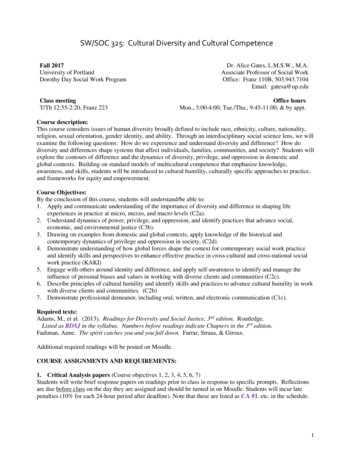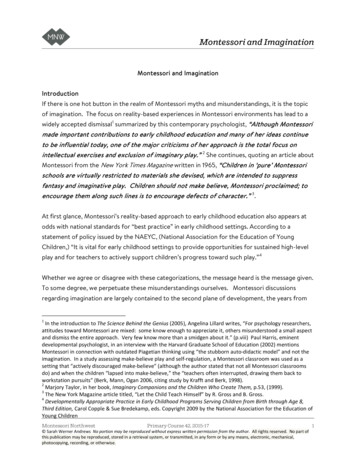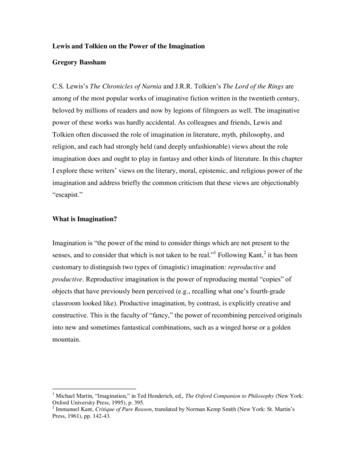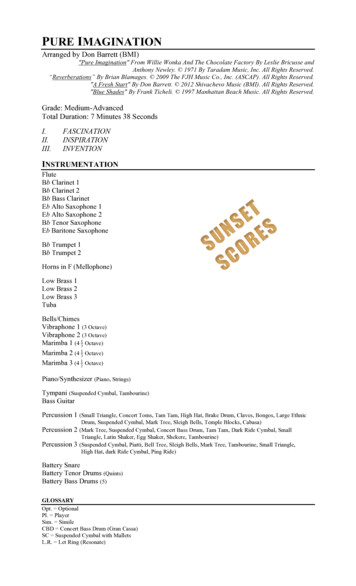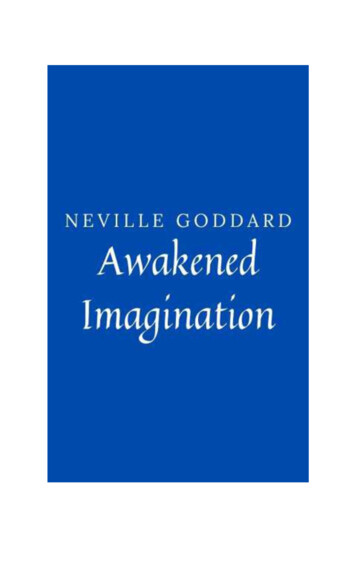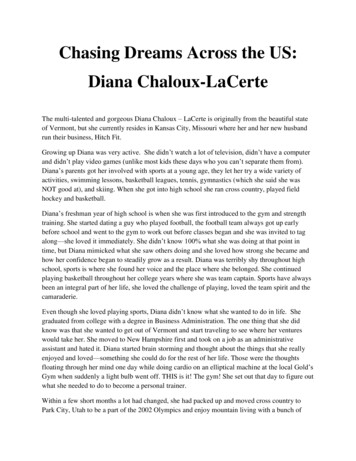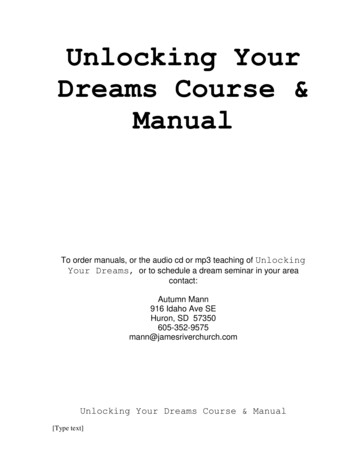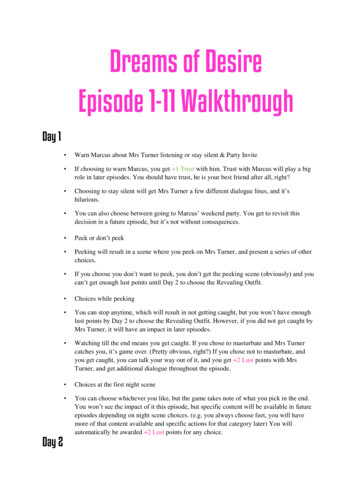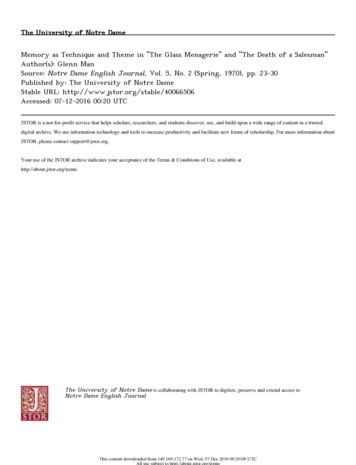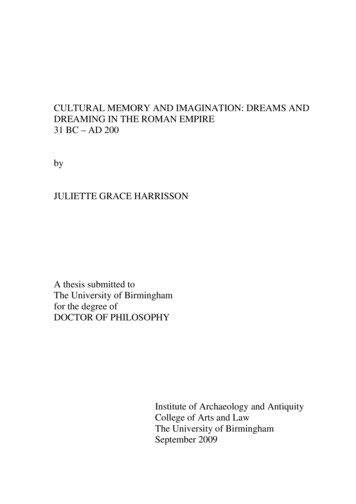
Transcription
CULTURAL MEMORY AND IMAGINATION: DREAMS ANDDREAMING IN THE ROMAN EMPIRE31 BC – AD 200byJULIETTE GRACE HARRISSONA thesis submitted toThe University of Birminghamfor the degree ofDOCTOR OF PHILOSOPHYInstitute of Archaeology and AntiquityCollege of Arts and LawThe University of BirminghamSeptember 2009
University of Birmingham Research Archivee-theses repositoryThis unpublished thesis/dissertation is copyright of the author and/or thirdparties. The intellectual property rights of the author or third parties in respectof this work are as defined by The Copyright Designs and Patents Act 1988 oras modified by any successor legislation.Any use made of information contained in this thesis/dissertation must be inaccordance with that legislation and must be properly acknowledged. Furtherdistribution or reproduction in any format is prohibited without the permissionof the copyright holder.
ABSTRACTThis thesis takes Assmann’s theory of cultural memory and applies it to anexploration of conceptualisations of dreams and dreaming in the early Roman Empire(31 BC – AD 200). Background information on dreams in different cultures,especially those closest to Rome (the ancient Near East, Egypt and Greece) isprovided, and dream reports in Greco-Roman historical and imaginative literature areanalysed. The thesis concludes that dreams were considered to offer a possibleconnection with the divine within the cultural imagination in the early Empire, butthat the people of the second century AD, which has sometimes been called an ‘age ofanxiety’, were no more interested in dreams or dream revelation than Greeks andRomans of other periods.This thesis outlines, defines and applies the newly developed concept of culturalimagination, developed from cultural memory, to its examination of dreams anddream reports in Greco-Roman literature. Using the concept of cultural imagination inpreference to discussing ‘belief’ is shown to have advantages for the study of ancientreligion, as it allows the historian to discuss religious ideas that may or may not havebeen widely ‘believed’ but which were present within the imagination of the membersof a particular society.
DEDICATIONFor Mum, Dad and Ed: I couldn’t have done it without you
ACKNOWLEDGMENTSFirst and foremost I want to thank my supervisor, Ken Dowden, for many hours of meetings,heated discussions, unfailing support and the odd glass of wine at the bar.Many other members of staff at the University of Birmingham have also helped me with thisthesis. I want to thank Niall Livingstone for help with Latin and Greek, for general comments,and for much helpful advice. Thanks also to Alasdair Livingstone, Birgit Haskamp and MartinBommas for advice, comments and corrections on ancient Near Eastern and Egyptian material.I would also like to thank Diana Spencer for all her help and support over the years, particularlyat the start of the project.My thanks also to W. V. Harris, who very kindly sent me a copy of his book, Dreams andExperience in Classical Antiquity, which was published just last summer and which has been aninvaluable resource and springboard for ideas. I would also like to thank Caroline Lawrence forsending me several of her works of children’s fiction set in ancient Rome, which use dreams ina very interesting way and which have enriched my wider conclusions.I must also thank everyone at the IAA Forum for the opportunity to practise papers, gainvaluable feedback, for their comments, suggestions and notes, and for many hours de-stressingat the pub. Thanks as well to everyone in the Postgraduate Study Room, especially the twoLauras, for support, many cups of coffee and general solidarity in the face of endless hours atthe computer.Thank you to the AHRC for funding this project and to Laura and Jack for putting a roof overmy head in the final stages.Finally, thank you to Mum, Dad and Ed, without whose support, both emotional and morepractical, I would never have even started.
TABLE OF CONTENTSINTRODUCTIONMemory and Imagination: Aims of this StudyLiterature of Record and Imaginative LiteratureCultural Memory and Cultural ImaginationWhat is a Dream?How Universal are Dreams?Dream ReportsThe State of Scholarship on Dreams126917232833PART ONE: CONTEXTCHAPTER ONECLASSIFYING DREAMSConceptualising Dreams: Dreaming in Different CulturesDream TerminologyDreams as MetaphorClassifying DreamsAncient Classifications of DreamsModern Scholarly Classifications of DreamsTo Classify or not To Classify?4343536165657280CHAPTER TWOHISTORICAL CONTEXT: DREAMS IN THE NEAR EAST, EGYPT ANDGREECEDivination in the Ancient WorldThe Ancient Near EastThe Politics of DreamingForebodings of Death: Gilgamesh and DumuziEgyptThe Power of DreamsDreams in the Greek WorldNew Beginnings? HomerThe Tragedy of DreamsA History of Dream Books8585899098101105107107114125PART TWO: CULTURAL MEMORY AND IMAGINATION: DREAM REPORTSIN ROMAN PERIOD LITERATURECHAPTER THREEWHY DID GRECO-ROMAN WRITERS RECORD DREAMS IN LITERATUREOF RECORD?135How Frequent are Dreams in Literature of Record?137Message Dreams139Interpreters and Interpretation142How are Dreams Used in Different Works of Record?145Dreams as Historical Explanation145
Birth and Death Omens: SuetoniusMorals, Character and Dreams: PlutarchThe Religious Significance of DreamsBy What Process Does a Dream Report Become a Cultural Memory?The Career Dreamer: AristidesDreams in the Cultural MemoryDreams That are Worthy of Remembrance: Valerius MaximusFrequently Reported Dreams: Titus Latinius and Calpurnia148153158163163171171176CHAPTER FOURTHE NATURE OF IMAGINATIVE DREAMS AND THEIR PLACE IN THECULTURAL IMAGINATIONThe Nature of Imaginative DreamsDreams That Come from the DivineDreams That Come Directly from the DivineDreams That Come Indirectly from the DivineDreams from the DeadGhost Stories: The Dead in Imaginative DreamsA Dream Ghost Story: PropertiusDreams That Come from Within the DreamerWish-fulfilment DreamsAnxiety Dreams: LucanConfusing your Characters: Symbolic DreamsInterpreters and InterpretationThe Audience as Dream InterpretersOn the Border: Ambiguous DreamsDouble Meanings: Apuleius’ 17219226227PART THREE: THE PLACE OF DREAMS IN THE GRECO-ROMANCULTURAL IMAGINATION: A POINT OF CONNECTION WITH THE DIVINE?CHAPTER FIVETHE PLACE OF DREAMS IN THE CULTURAL IMAGINATION IN THESECOND CENTURY AD‘Belief’ and Cultural ImaginationActing on Dreams: Message DreamsAetiological Explanations: PausaniasMessage Dreams for the Common Folk? Commands from the GodsConnecting with the Gods: Incubation Beyond AristidesReacting to Dreams: Symbolic DreamsDreams and MedicineRituals and Responses to DreamsDealing with Everyday Dreams: ArtemidorusA Place Within the Cultural Imagination: Satire and ScepticismChange and Continuity, Memory and Imagination: St PerpetuaCONCLUSIONSWhy did Greco-Roman Writers Record Dreams in their Histories and Fiction?Did People Living in the Roman Empire Imagine that Dreams Allowed forCommunication with the 09
Ancient and Modern DreamsCultural Memory and Imagination311313APPENDIX ONE: TABLES AND FIGURES315APPENDIX TWO: CATALOGUE340BIBLIOGRAPHY358
LIST OF TABLES AND FIGURESTable 1: Near Eastern sourcesTable 2: Archaic, Classical and Hellenistic Greek sourcesTable 3: Pre-Augustan Greek and Latin literatureTable 4: Imperial Latin Literature of RecordTable 5: Imperial Greek Literature of RecordTable 6: Aelius Aristides and ArtemidorusTable 7: Imperial Latin Imaginative LiteratureTable 8: Imperial Greek Imaginative Literature316319322325328331334337Figure 1: Near Eastern sourcesFigure 1b: Near Eastern sources (simplified version)Figure 2: Archaic, Classical and Hellenistic Greek sourcesFigure 2b: Archaic, Classical and Hellenistic Greek sources (simplified version)Figure 3: Pre-Augustan Greek and Latin literatureFigure 3b: Pre-Augustan Greek and Latin literature (simplified version)Figure 4: Imperial Latin Literature of RecordFigure 4b: Imperial Latin Literature of Record (simplified version)Figure 5: Imperial Greek Literature of RecordFigure 5b: Imperial Greek Literature of Record (simplified version)Figure 6: Aelius Aristides and ArtemidorusFigure 6b: Aelius Aristides and Artemidorus (simplified version)Figure 7: Imperial Latin Imaginative LiteratureFigure 7b: Imperial Latin Imaginative Literature (simplified version)Figure 8: Imperial Greek Imaginative LiteratureFigure 8b: Imperial Greek Imaginative Literature (simplified 338339
INTRODUCTIONοὗτος γὰρ ἐν μὲν ταῖς τῶν πέλας κατηγορίαις πολλὴν ἐπιφαίνει δεινότητα καὶτόλμαν, ἐν δὲ ταῖς ἰδίαις ἀποφάσεσιν ἐνυπνίων καὶ τεράτων καὶ μύθων ἀπιθάνωνκαὶ συλλήβδην δεισιδαιμονίας ἀγεννοῦς καὶ τερατείας γυναικώδους ἐστὶ πλήρης.‘In attacking others he shows cleverness and courage; when it comes to his own writing,he is full of dreams and wonders and improbable myths; in short, full of superstition andold wives' tales.’Polybius on Timaeus, 12.24.5.These few lines of Polybius encapsulate two radically different approaches to dreamsfrom ancient writers. On the one hand, we have Timaeus, who supposedly filled hisworks with dreams and other ‘irrational’ elements, and on the other, we have Polybius,who claims to shun such things entirely. Why were writers like Timaeus interested indreams and what did they think was worthy of remembrance in dream reports? Howmuch of the attitude of Greeks and Romans to dreams was unique to their own culturalheritage and how far were they influenced by others around them?This study explores the place of dream reports, and indeed dreams themselves,within the cultural memory and imagination of the Roman Empire. There have been anumber of studies on ancient dreams in recent years, most notably W. V. Harris’important volume Dreams and Experience in Classical Antiquity (see below), but theapplication of the theory of cultural memory, as developed by Maurice Halbwachs andJan Assman, to this quintessentially ‘remembered’ topic has yet to be exploited. Theperiod of the Roman Empire (and in Chapter Five, the second century AD) has beenchosen because this is a period during which, scholars have sometimes asserted, there1
was an increased feeling of religiosity among a disenfranchised people. 1 This is theperiod of deified emperors, messiahs, magicians and imperial bans on witchcraft anddivination. As far as dreams are concerned, this period saw active use of incubatoryshrines, large numbers of inscriptions claiming to have been set up on order receivedthrough a dream, numerous dream reports appearing in historical works and theappearance of Aristides’ Hieroi Logoi, Artemidorus’ Onirocritica (Dream Interpretationbook) and Apuleius’ Metamorphoses. This is quite possibly the most fruitful period forthe study of ancient dream reports.Memory and Imagination: Aims of this StudyThis study poses two central questions about the relationship of dreams and dreaming tomemory and imagination in the Roman Empire.First, for what reasons did Greco-Roman writers record dreams in their historiesand fiction? (How and why did certain dream reports enter into the cultural memory of anevent and stay there? To what extent did earlier treatments of dreams survive into theRoman period? How did people in the ancient Near East, Egypt and Greece conceptualisedreams and dreaming? To what extent did their ideas survive into the Roman period? Towhat extent might ideas about dreams be transmitted through migration, and trade, and towhat extent do differing cultures come to similar conclusions independently? What wasthe significance of dreams for the cultural memory?)1See Dodds 1965: 3.2
Secondly, did people living in the Roman Empire imagine that dreams presentedan opportunity for communication with the divine? By answering this question, we mayattempt to define the place of dreams within the cultural imagination – asking not justwhether or not people ‘believed’ that dreams might open up a communication withsomething divine, but whether this idea, believed in or not, was stronger within theRoman Empire, particularly in the second century AD, than it is now or was in othercultures.This study is divided into three parts. Part One provides terminological, classificatory,literary and historical contexts for the material studied. Chapter One will explore thelanguage and classification of dreams. This chapter opens with an overview of ideasabout dreaming from many different places and cultures. This overview will act as acontrol of sorts, allowing us to identify ideas about dreams that are common to manyunconnected societies. This chapter will then define the parameters of this study,discussing various ways of classifying dreams and dream reports and explaining thecategories adopted in the rest of the study.Chapter Two will establish the historical context of dream reports under theRoman Empire. Focussing on those areas which had the greatest impact on the GrecoRoman world – Egypt, the Near East and, of course, classical Greece – this chapter willbriefly establish the place of dreams within cultural memory and imagination in theseareas, in order to trace ideas that might have been transmitted through migration, trade,and so on. In order to answer the question of how far earlier approaches to dream reportssurvived into the Roman period, it will first be necessary to establish the place of dreamreports in earlier literature.3
Part Two of the study aims to answer the first of our two questions and explainwhy Greek and Roman writers of historical and imaginative literature included dreamreports in their writing. Dream reports have an enduring popularity in imaginative writingto this day, but are not usually included in modern literature of record, though in GrecoRoman historical writing, especially during the Imperial period, they appear quitefrequently. Chapter Three focuses on literature of record, and on the place of dreamswithin Greco-Roman cultural memory. It is important to note here that this formulation isfor convenience only. Naturally, there was never a single ‘Greco-Roman culturalmemory’ which applied to all people across the Roman world over two centuries.However, since this study covers a wide range of material, it is necessary to adopt termswith which to discuss the issues at hand and to generalise to some extent. The term‘Greco-Roman cultural memory and imagination’ refers to the core of cultural memoryand imagination shared by a majority of people within the period; future studies mayexamine smaller areas within a tighter chronological scope. By laying out the ways inwhich dreams are used in literature of record and investigating some particularlyfrequently reported dreams, this chapter will establish some of the reasons why dreamswere used so much more often in historical literature of this period than they are inmodern historical writing, both academic and popular.Chapter Four looks at imaginative literature and asks how the dream storiesreported in imaginative literature fit into the cultural imagination. Dream stories arepopular in the literature of many different cultures, but the nature and use of dreamstories within Greco-Roman imaginative literature in particular may reveal somethingabout the place they held within the Greco-Roman imagination. This chapter will alsostart to explore what will become a central theme of Chapter Five – the imagined source4
of dreams. Imaginative literature gives us a unique insight into this issue because theauthor can choose whether or not definitively to reveal the source of a dream, and thischoice will give a hint as to the place of dreams within the author’s, and their audience’s,imagination.Part Three provides a synthesis, a summing up of the place of dreams withinGreco-Roman memory and imagination. Chapter Five looks specifically at the secondcentury AD, the era that produced some of the most prolific ancient writers on dreams,including Aelius Aristides, Artemidorus and Apuleius. This chapter questions how far wecan build up a picture of genuine dream ‘belief’ in the second century AD and askswhether Greco-Romans of the second century AD imagined that dreams might be aconduit for communication with the divine or the dead.The methodology used in this study varies slightly from chapter to chapter. Chapters Oneand Two (Part One) are wide-ranging and diachronic. They look at a wide range ofevidence, in order to gain entry into dreams and conceptualisations of dreams in a varietyof times and places, to explore how unique or otherwise any one culture’s ideas may be.Chapter One incorporates anthropological material on conceptualisations of dreaming invarious cultures as well as etymological material concerning Greece and Rome, in itswide overview of thought on dreams and dreaming. Chapter Two is more historical,drawing on recent work on Egyptian and Near Eastern dreams, and moving into morephilological territory with its look at dreams around the Mediterranean in the ancientworld.Chapters Three and Four (Part Two) are textually based. They explore the natureand functions of dream reports in Greek and Latin literature of the early Imperial period.5
Chapter Five (Part Three) comprises a more synchronic approach, utilisingmaterial from previous chapters, as well as looking at other aspects and other sources ofevidence, such as inscriptions, to build up a picture of dreams and dreaming in the secondcentury AD. In discussing the nature of ‘belief’, Chapter Five draws briefly onanthropological and sociological theory. The bulk of the chapter is concerned with thehistory of religion, and with the history of religion in the Greco-Roman world in thesecond century AD in particular.Literature of Record and Imaginative LiteratureDel Corno suggests that there are two types of writing about dreams – that whichdiscusses their nature, origin and divinatory function, and that which discusses theirinterpretation. 2 However, his second category bears some further division. There areworks such as Artemidorus Onirocritica, which are devoted to the nature of dreaminterpretation as a skill and the to process of interpreting dreams, and, quite differently,there are works which report that so-and-so had a dream, and afterwards, such-and-such athing happened, which might loosely be called interpretation. It is these dream reportswhich are the focus of this study.A dream report that has been recorded as accurately as possible from memory and writtendown is clearly not the same as a dream that has been invented by an author and given toa fictional character. However, the boundaries between history and fiction in ancient2Del Corno 1978: 1605.6
literature are so blurred that it is impossible for any scholar to simply separate historyfrom fiction. Plutarch’s biographies are all written as historical works, but the dreamsincluded in his Theseus or Romulus can hardly be historical; on the other hand, the dreamof Pompey from Lucan’s Bellum Civile has an historical origin, but has been altered forthe fictionalised epic poem. Epic poems are often viewed by ancient scholars ashistorical, while historical works include much mythical material, as well as variousadditions invented by the author, especially speeches.Bowersock has suggested that the category of ‘fiction’ must include not only‘overt works of the imagination’ but also ‘the rewriting of the mythic and legendary pastas part of the creation of the new and miraculous present’. 3 He has identified four typesof fiction in the Roman empire (fantastic tales, Homeric revisionism, tragic/romanticnovels and comic/satiric novels) and argues that the ‘explosion of fiction’ in the empirebegan during the reign of Nero. 4However, extending the label of ‘fiction’ to historical works in the ancient worldsometimes creates more problems than it solves. In his first chapter, Bowersock discussesvarious sources, including Lucian’s True Story and the Christian Gospels, and hesuggests that the fictional narratives which have survived from this period must be seen‘within this larger context of fabrication and rewriting’. Bowersock acknowledges thatthe novels ‘do not purport to be a historical record of facts in the same way’ as theGospels, but emphasises the links between them. 5 It is certainly true that there are linksbetween the Gospels and the novels, and the comparison is often a helpful one. 63Bowersock 1994: 13.Bowersock 1994: 21-22.5Bowersock 1994: 13.6This extends beyond just the Christian Gospels; for example, Pelling has suggested that Plutarch used anumber of overtly literary techniques in his biographies, including conflation of material, chronological47
However, for the purposes of this study, the essential difference between deliberate, overtfiction and historical works cannot be ignored. It is entirely possible that some historicalworks contain deliberately fictionalised, false elements; others may be entirely composedof orally transmitted stories that the author either believed to be true or consideredvaguely possible and included in the absence of any alternative. Without the ability tocross-examine the author, we can only examine the work according to its intendedpurpose, whether this be to record something for posterity, or to entertain and move itsreaders through artistic writing.It is for these reasons that this study adopts the terms ‘literature of record’ and‘imaginative literature’. ‘Literature of record’ refers to accounts which aim to recordvaluable information, usually information which purports to be history, even if it isunreliable history. ‘Imaginative literature’ refers to stories invented or, in the case ofmythic or historically-based stories, re-imagined by the author. Lucan’s Bellum Civile,because it is an epic poem in which the artistic requirements of the poem take precedenceover historical accuracy and a certain amount of poetic licence is to be expected, isliterature of imagination. Plutarch’s Lives of Theseus and Romulus and the early sectionsof Livy’s History of Rome, despite their mythological subject matter and known authorialinterpolations, are literature of record, because the underlying aim of these works is torecord Greek and Roman history for posterity.The division between literature of record and imaginative literature places theemphasis on the nature of the work in which the dream report is found. Whether thedream really happened or not is largely irrelevant. Dream reports play a very differentrole in literature of record, in which the purpose is to create a lasting record of a people orcompression and dislocation and fabrication of circumstantial detail, and it is certainly helpful to recogniseand acknowledge these techniques when analysing Plutarch; Pelling 1980: 127.8
of a period, than they do in imaginative literature, in which the primary purpose is tocreate a work of artistic merit. These categories are not exhaustive or exclusive; manyancient historians were very keen to ensure that they wrote works of artistic merit andmany imaginative works, especially epic poems, are designed to encapsulate the nature ofa people or of a period. However, the use of the terms ‘record’ and ‘imagination’ isdesigned to reflect the chief raison d’être of each work; is it intended primarily as arecord of something, or is its primary purpose as an imaginative work of art? If it is awork of record, its use of dream reports will be concerned with what memories theyencapsulate relating to the people concerned, with what they say about these people atthat time and their effect on later developments. Dream reports in imaginative literaturehave many different functions, but overall will be more concerned with deepening theimaginative world the author has created. They may be described in more detail, andreveal more about the way the writer perceives the world and the relationship between themortal and the divine, as the imaginative author can describe the invented process inmuch more detail than is possible for the author who records memories of an historicalevent.Cultural Memory and Cultural ImaginationWe owe the term ‘cultural memory’ (kulturelle Gedächtnis) to Jan Assmann. The termwas inspired by Maurice Halbwachs’ ‘collective memory’ (la mémoire collective) andlater developed by Assmann to refer to historical stories shared by members of a9
culturally distinct group of people. 7 These may be orally transmitted, or commemoratedvia historical writing, inscriptions, visual art or other media. The collective, culturalmemory of a group establishes and reinforces that group’s sense of identity. As Assmannputs it,Cultural memory has. fixed points [which] are fateful events of the past,whose memory is maintained through cultural formation. and institutionalcommunication. We call these “figures of memory”. 8Autobiographical memory, as defined by Halbwachs, is a person’s own memory ofevents that occurred in their own lives, as opposed to collective memory. 9Collective memory was not entirely abandoned in the years between Halbwachs’ andAssmann’s work. Nora’s work on ‘les lieux de mémoire’ discussed the importance ofstudying the memory as itself, rather than as a source for the original event. 10 Connertonexplored performative and bodily ‘social memory’, focussing on ritual performances andarguing that social memory is most often found in commemorative performances. 11Psychoanalyst Spence’s work focussed on the ways in which the individual reconstructsevents to produce a new, narrative memory, but has clear implications for recorded,especially autobiographical, history. 12 More recently, Carruthers has drawn on the7See Assmann 2000: 11. On Halbwach’s theory of collective memory, see Coser’s introduction to hisedited volume of Halbwachs’ work; Halbwachs 1992: 21-28. On the development of Halbwach’s ideasconcerning la mémoire collective, see also Dechaux 1998: 624-625.8Assman 1995: 129.9See Halbwachs 1992: 24.10Nora 1989: 23-24.11Connerton 1989: 4-5.12Spence 1982: 166-168.10
concepts of collective and cultural memory to explore the idea of memoria rerum, using‘things’ (which can be objects, texts or buildings) to inform memory. 13However, it was Jan Assmann who revived and reinvigorated the study of collectivememory, developing from Halbwach’s ‘collective memory’ his own theory of ‘culturalmemory’. 14 Assmann distinguished various types of social memory. ‘Communicativememory’ (kommunikativen Gedächtnis) is the social aspect of individual memory, bywhich individual, autobiographical memories are transmitted between individuals. 15‘Collective memory’ (Kollektivgedächtnis) refers to shared memories whose task is totransmit a collective identity, and this is particularly susceptible to politicalinterference. 16 ‘Cultural memory’ (kulturelle Gedächtnis) is a step beyond collectivememory, and refers to shared memories which become part of a tradition, beyond thethree-generation cycle of communicative memory. 17 Assmann describes communicativememory as characterised by its proximity to the everyday, and cultural memory ascharacterised by its distance from the everyday. 18The process of remembering a dream has several stages. First, there is the personalmemory of the dream itself; an autobiographical memory that Assmann would term‘scenic’, being episodic and incoherent. 19 Then there is the relation of the dream to athird party, in which the memory is transformed into a narrative and becomes what13Carruthers 1998: 35.The term ‘collective memory’ or mémoire collective is also still in use, but is not always so clearlydefined; for example, Van Mal-Maeder uses it in reference to the influence of Homer on later writers andartists; Van Mal-Maeder 2004-2005: 311.15Assmann 2000: 13 (see also Assmann 2006: 3).16Assmann 2000: 17 (see also Assmann 2006: 6-7).17Assmann 2000: 18-19 (see also Assmann 2006: 8).18Assmann 1995: 128-129.19Assmann 2006: 2.1411
Assmann terms a ‘communicative’ memory. 20 The dream may then be recorded inwritten form in a document intended for publication and wide dissemination, becoming acollective memory. Finally, a particularly significant dream report, such as that ofCalpurnia before the assassination of Caesar, may become part of the politicised,deliberate public remembrance of an event which contributes to the formation of acultural identity, and so becomes a cultural memory. 21We may divide this process into three major stages: the ‘real’ dream (which wecannot access), the ‘recalled’ dream (remembered by the dreamer and reported to a thirdparty), and the ‘culturally remembered’ dream (reported and widely disseminated).Mentally layering the dream report into these three stages elides Assmann’s carefullydrawn distinction between ‘collective memory’ and ‘cultural memory’. For the purposesof this study, this distinction is not particularly important or meaningful. Most dreamreports in ancient literature of record are written down long after the event, often outsideof the three-generation cycle of memory, and those that are written down sooner arerecorded with the specific purpose of ensuring that people continue to remember themand that they enter the tradition. In dealing with ancient historians, we are always dealingwith a tradition, and, therefore, in Assmann’s terms, with cultural memory.The term ‘cultural imagination’ has appeared from time to time in a wide variety of work.The term can be used in subtly different ways in very different fields of study and anumber of scholarly studies have used it, but generally they have not defined or20Assmann 2006: 3. Although Nora suggests that memory and history are fundamentally opposed to eachother, the history that ancient writers wrote, designed to preserve the memory of the most important peopleand events so that future generations would remember them, is, inherently, a product and vehicle ofmemory; Nora 1989: 8-9.2
exploration of conceptualisations of dreams and dreaming in the early Roman Empire (31 BC – AD 200). Background information on dreams in different cultures, especially those closest to Rome (the ancient Near East, Egypt and Greece) is provided, and dream reports in Greco-
